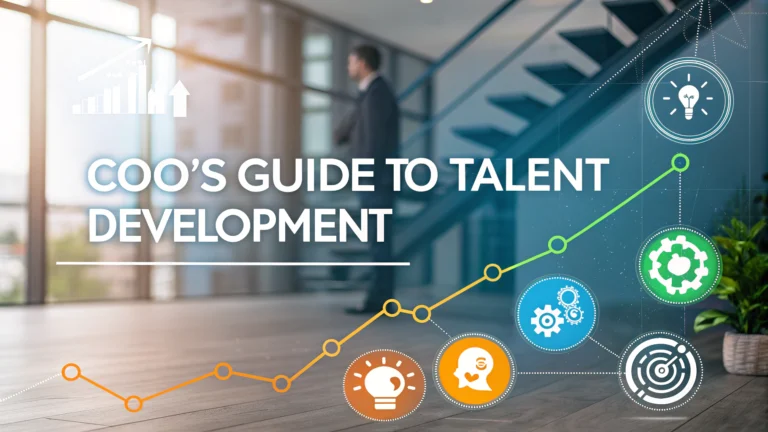Creating a robust talent development strategy is one of the most significant responsibilities of a Chief Operating Officer.
A well-designed talent development program directly impacts operational efficiency, employee retention, and organizational growth.
This guide outlines practical approaches for COOs to build and maintain effective talent development initiatives that align with business objectives.
Essential Components of Talent Development
- Skills assessment and gap analysis
- Individual development plans
- Leadership pipeline programs
- Succession planning
- Performance metrics tracking
Implementing a Skills Assessment Framework
Start with a company-wide skills audit to identify current capabilities and gaps.
Use assessment tools like LinkedIn Learning or Gallup CliftonStrengths to evaluate employee competencies.
Creating Individual Development Plans (IDPs)
| Component | Description |
|---|---|
| Career Goals | Short and long-term professional objectives |
| Skill Gaps | Areas requiring development |
| Action Steps | Specific activities to achieve goals |
| Timeline | Target dates for completion |
Building a Leadership Pipeline
Establish a structured leadership development program that identifies and nurtures high-potential employees.
- Mentorship programs
- Rotation assignments
- Executive shadowing
- Leadership workshops
Measuring Success
Track these key performance indicators (KPIs):
- Employee retention rates
- Internal promotion rates
- Training completion rates
- Performance improvement metrics
- Return on investment (ROI) for training programs
Technology Integration
Implement these recommended learning management systems (LMS):
Budget Allocation
Allocate resources based on this recommended distribution:
- 40% – Technical skills training
- 30% – Leadership development
- 20% – Soft skills enhancement
- 10% – Industry-specific certifications
Next Steps for Implementation
Contact professional development organizations like ATD (Association for Talent Development) or SHRM for additional resources and certification programs.
Schedule quarterly reviews to assess program effectiveness and make necessary adjustments.
Document success stories and share them across the organization to maintain momentum and engagement.
Ongoing Program Maintenance
Regular review and refinement of talent development initiatives ensure continued effectiveness and relevance.
- Quarterly program assessments
- Feedback collection from participants
- Industry trend analysis
- Competitive benchmarking
Cross-Functional Development
Implement initiatives that promote versatility and organizational understanding:
- Department rotation programs
- Cross-functional projects
- Skill-sharing workshops
- Innovation labs
External Partnerships
Educational Institutions
- University partnerships
- Industry certification programs
- Professional associations
Corporate Alliances
- Vendor training programs
- Industry consortiums
- Knowledge exchange networks
Risk Management
Address potential challenges in talent development:
| Risk Factor | Mitigation Strategy |
|---|---|
| Employee turnover | Knowledge transfer protocols |
| Budget constraints | ROI-focused program selection |
| Technology adoption | Phased implementation approach |
Driving Sustainable Talent Excellence
Ensure long-term success through:
- Continuous program evolution
- Data-driven decision making
- Stakeholder engagement
- Cultural integration
- Innovation in learning methods
Remember that talent development is an ongoing journey rather than a destination. Regular refinement and adaptation of these strategies will create a resilient and capable workforce ready to meet future business challenges.
FAQs
- What are the primary responsibilities of a COO regarding talent development?
A COO oversees the implementation of talent development strategies, ensures alignment with business objectives, allocates resources for training programs, and monitors the effectiveness of development initiatives across departments. - How should a COO measure the success of talent development programs?
Success metrics include employee retention rates, internal promotion rates, skill gap analysis results, employee satisfaction scores, productivity improvements, and return on investment (ROI) of training programs. - What role does succession planning play in a COO’s talent development strategy?
Succession planning is crucial for identifying and developing future leaders, ensuring business continuity, reducing recruitment costs, and maintaining organizational knowledge through structured leadership development programs. - How can COOs align talent development with business strategy?
By conducting regular skills gap analyses, creating development programs that address future business needs, ensuring training initiatives support strategic goals, and maintaining constant communication with department heads. - What are effective methods for identifying high-potential employees?
Methods include performance reviews, 360-degree feedback, assessment centers, leadership potential evaluations, competency assessments, and tracking project success rates. - How can COOs ensure equitable access to development opportunities?
By implementing transparent selection processes, creating standardized development paths, offering diverse learning options, monitoring participation demographics, and establishing clear criteria for program eligibility. - What technology solutions should COOs consider for talent development?
Learning Management Systems (LMS), performance tracking software, skill assessment tools, e-learning platforms, mentoring software, and analytics tools for measuring development outcomes. - How should COOs budget for talent development initiatives?
By analyzing historical training costs, benchmarking against industry standards, calculating potential ROI, considering both direct and indirect costs, and allocating resources based on strategic priorities. - What role should mentoring play in talent development strategy?
Mentoring should be a key component that pairs experienced leaders with emerging talent, facilitates knowledge transfer, accelerates professional growth, and helps preserve institutional knowledge. - How can COOs ensure knowledge retention within the organization?
Through documented processes, cross-training programs, creating knowledge bases, implementing shadowing programs, and establishing communities of practice.
